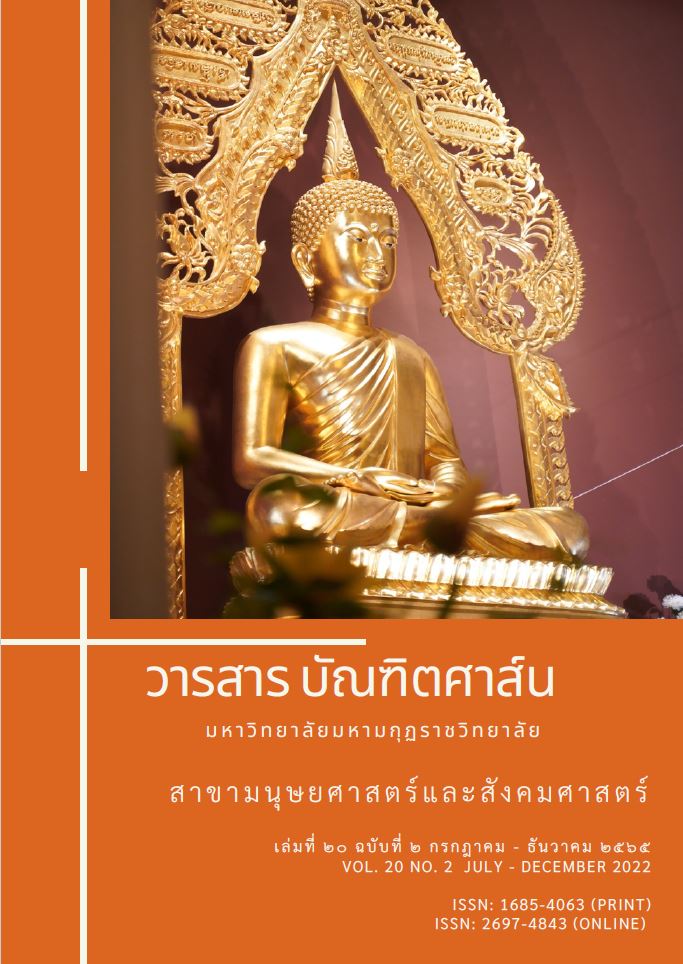รูปแบบการเผยแผ่คำสอนพระพุทธศาสนาตามช่วงวัยในสังคมปัจจุบัน
คำสำคัญ:
รูปแบบการเผยแผ่, คำสอนในพระพุทธศาสนา, ช่วงวัยในสังคมยุคปัจจุบันบทคัดย่อ
ดุษฎีนิพนธ์นี้ มีวัตถุประสงค์ ดังนี้ 1. เพื่อศึกษาสภาพการเผยแผ่คำสอนพระพุทธศาสนาในสังคมยุคปัจจุบัน 2. เพื่อพัฒนารูปแบบการเผยแผ่คำสอนพระพุทธศาสนาตามช่วงวัยในสังคมยุคปัจจุบัน 3. เพื่อเสนอรูปแบบการเผยแผ่คำสอนพระพุทธศาสนาตามช่วงวัยในสังคมยุคปัจจุบัน เป็นการวิจัยแบบผสานวิธี (Mixed Methods Designs) โดยมีวิธีดำเนินการวิจัยจากเอกสารขั้นปฐมภูมิ และเอกสารตำราวิชาการ สอบถามกับกลุ่มตัวอย่างในคน 4 เจเนอเรชัน จำนวน 136 คน และสัมภาษณ์เชิงลึก (In-depth interview) ผู้ทรงคุณวุฒิด้านการเผยแผ่พระพุทธศาสนา จำนวน 14 รูป/คน
ผลการวิจัยพบว่า ในปัจจุบันผู้เผยแผ่คำสอนในพระพุทธศาสนามีทั้งบรรพชิตและคฤหัสถ์ ทั้งเทศน์สอนโดยตรงและสอนผ่านสื่อที่สามารถเข้าถึงกลุ่มคนได้ เช่น หนังสือธรรมะ รายการโทรทัศน์ รายการวิทยุ คลิปวีดีโอ บทความ ข้อความสั้น ๆ ประกอบรูปภาพในสื่อโซเชียลเนตเวิร์ค รวมไปถึงการจัดกิจกรรมค่ายธรรมะด้วย ซึ่งแนวทางการสอนของผู้เผยแผ่จะดึงดูดกลุ่มผู้ฟังที่ชอบแนวทางนั้น ส่วนความสนใจของผู้ฟังนั้นมีส่วนในการกำหนดแนวทางการสอนและการเลือกเนื้อหาของผู้เผยแผ่ด้วย ทั้งนี้ผู้เผยแผ่ต่างทำหน้าที่เผยแผ่คำสอนตามแนวทางที่ตนเองถนัด ไม่ได้มีความร่วมมือในการเผยแผ่อย่างเป็นรูปธรรม รูปแบบการเผยแผ่คำสอนในพระพุทธศาสนาตามช่วงวัยควรให้ความสำคัญกับทุกองค์ประกอบไม่ว่าจะเป็นผู้สอนที่ควรศึกษาคำสอนนำมาพัฒนาคุณธรรมของตน และศึกษาหาความรู้เกี่ยวกับเทคโนโลยีที่สามารถนำมาใช้ให้เป็นประโยชน์ต่อการเผยแผ่ เนื้อหาคำสอนควรเป็นเนื้อหาที่ผู้ฟังสนใจ ปรับให้ง่ายเหมาะกับวุฒิภาวะของผู้ฟังในแต่ละเจเนอเรชัน ทำให้เกิดความประทับใจ คลายข้อสงสัยและสามารถนำหลักคำสอนไปใช้แก้ปัญหารวมถึงการพัฒนาชีวิตและจิตใจให้ดีขึ้น สื่อและวิธีการที่ใช้ควรเป็นสื่อที่เข้าถึงกลุ่มคนได้ง่าย ไม่ซับซ้อน การเผยแผ่ต้องอาศัยประสบการณ์ของผู้เผยแผ่ที่รู้จักยืดหยุ่น ปรับเปลี่ยนทั้งสื่อและวิธีการให้สอดคล้องกับความต้องการของผู้ฟัง ดังรูปแบบการเผยแผ่คำสอนพระพุทธศาสนาตามช่วงวัยในสังคมยุคปัจจุบัน คือ EPIE Model
เอกสารอ้างอิง
กรกต ชาบัณฑิต,เกษมชาติ นเรศเสนีย์ และภิศักดิ์ กัลยาณมิตร. (2556). ยุทธศาสตร์การเผยแผ่พระพุทธศาสนาเชิงรุก.วารสารบัณฑิตศึกษา มหาวิทยาลัยราชภัฏวไลยอลงกรณ์ ในพระบรมราชูปถัมภ์ม 7(2), 56-67.
กรมประชาสัมพันธ์, Generation กับพฤติกรรมการรับข่าวสารผ่านสื่อต่าง ๆ. สืบค้นเมื่อ 2พฤษภาคม 2562 จาก http://edoc.mrta.co.th/HRD/Attach/1566372710_1.pdf
กาญจนาณัฐ ประธาตุ. (2560). พระพุทธศาสนากับสังคมไทย : การยืนหยัดและท้าทายในรอบทศวรรษ (พ.ศ. 2548 – 2558). วารสารพุทธจิตวิทยา, 1(1), 35-48.
คงชิต ชินสิญจน์. (2551). การพัฒนารูปแบบการประชาสัมพันธ์เพื่อเผยแผ่พระพุทธศาสนาของมหาวิทยาลัยมหามกุฏราชวิทยาลัย. ดุษฎีนิพนธ์ปริญญาศาสนศาสตร์ดุษฎีบัณฑิต,
สาขาวิชาพุทธศาสน์ศึกษา, บัณฑิตวิทยาลัย, มหาวิทยาลัยมหามกุฏราชวิทยาลัย.
ทีมข่าวศาสนา ไทยรัฐออนไลน์. (2560). อีเลิร์นนิงธรรมศึกษา มิติใหม่วงการคณะสงฆ์ พัฒนาหลักสูตรการเรียนการสอนพระพุทธศาสนา. สืบค้นเมื่อ 15 กันยายน 2561, จาก https://www.thairath.co.th/content/1143670
ทรงวิทย์ แก้วศรี. (2550). การศึกษาวิเคราะห์ยุทธวิธีในการประกาศพระพุทธศาสนาของพระพุทธเจ้า. ดุษฎีนิพนธ์ปริญญาพุทธศาสตรดุษฎีบัณฑิต, สาขาวิชาพระพุทธศาสนา
บัณฑิตวิทยาลัย, มหาวิทยาลัยมหาจุฬาลงกรณราชวิทยาลัย.
ทัศนีย์ เจนวิถีสุข. (2554). การสื่อสารเชิงพุทธกับการเปลี่ยนแปลงสังคม. ดุษฎีนิพนธ์ปริญญาพุทธศาสตรดุษฎีบัณฑิต, สาขาวิชาพระพุทธศาสนา, บัณฑิตวิทยาลัย, มหาวิทยาลัยมหาจุฬาลงกรณราชวิทยาลัย.
บุบผา เมฆศรีทองคา และขจรจิต บุนนาค. (2557). พฤติกรรมการบริโภคข่าวผ่านสื่อเฟซบุ๊คของคนต่างวัยในสังคมไทย, วารสารบัณฑิตศึกษา มหาวิทยาลัยราชภัฏวไลยอลงกรณ์ ในพระบรมราชูปถัมภ์, 8(3), 230-247.
ประยูร วงศ์จันทรา,ดร. (2552). พุทธวิธีการสอนจริยธรรม. วารสารวิชาการ มหาวิทยาลัยหอการค้าไทย,29(3), 167.
พระครูโฆษิตสังฆพิทักษ์ (ประเวท ถาฐาน). (2560). กลยุทธ์ในการเผยแผ่พระพุทธศาสนาของพระสงฆ์ไทยในสังคมปัจจุบัน, วารสารวิชาการธรรมทัศน์, 11(3), 211-223.
พระครูสิริธรรมบัณฑิต (ภาณุวัฒน์ แสนคำ), พระครูพิพิธสุตาทร (บุญช่วย สิรินฺธโร), พูนชัย ปันธิยะ.(2564). รูปแบบการเผยแผ่พระพุทธศาสนาของพระสงฆ์ที่เหมาะสมกับการเรียนรู้ในศตวรรษที่ 21, วารสารมจร สังคมศาสตร์ปริทรรศน์, 10(2),160-170.
พระมหาลิขิต คำหงษา.(2550). การสอนยึดเด็กเป็นศูนย์กลางตามแนวพุทธศาสตร์. สืบค้นเมื่อ 15 กันยายน 2561, จาก www.mcu.ac.th.
มนัสวี ศรีนนท์. (2561). ทฤษฎีเจเนอเรชันกับกรอบวิธีคิด, วารสารศึกษาศาสตร์ มมร., 6(1), 364-373.
รชต แหล่งสิน,นาวาเอก. (2555). บูรณาการการเผยแผ่พระพุทธศาสนาเถรวาทด้วยเทคนิคหลังนวยุค. ดุษฎีนิพนธ์ปริญญาศาสนศาสตร์ดุษฎีบัณฑิต, สาขาวิชาพุทธศาสน์ศึกษา, บัณฑิตวิทยาลัย
มหาวิทยาลัยมหามกุฏราชวิทยาลัย.
สิริวรรณ ไมตรีจิต. (2555). พุทธจิตวิทยาการสอนในพระไตรปิฎก.ดุษฎีนิพนธ์ปริญญาศาสนศาสตร์ดุษฎี บัณฑิต, สาขาวิชาพุทธศาสน์ศึกษา, บัณฑิตวิทยาลัย, มหาวิทยาลัยมหามกุฏราชวิทยาลัย.
สำนักข่าวอิศรา. (2555). 7 พฤติกรรมการสื่อสารคนรุ่น Y. สืบค้นเมื่อ 10 มกราคม 2563จาก:https://www.isranews.org/isranews-article/7024-7-y.html
อติพล เอื้อจรัสพันธุ์. (2561). พฤติกรรมการใช้สื่อของกลุ่มเจ็นเนอเนชั่นเอ๊กซ์ และเจ็นเนอเรชั่นวาย, วารสารวิชาการนวัตกรรมสื่อสารสังคม, 6(1), 59-65.
Cybervanaram. (2554), พระพุทธศาสนากับปัญหาที่ท้าทายในปัจจุบัน. สืบค้นเมื่อ11 ตุลาคม 2560, จาก https://www.cybervanaram.net
ดาวน์โหลด
เผยแพร่แล้ว
รูปแบบการอ้างอิง
ฉบับ
ประเภทบทความ
สัญญาอนุญาต
ลิขสิทธิ์ (c) 2022 มหาวิทยาลัยมหามกุฏราชวิทยาลัย

อนุญาตภายใต้เงื่อนไข Creative Commons Attribution-NonCommercial-NoDerivatives 4.0 International License.
บทความวิชาการและบทความวิจัยในวารสารฉบับนี้ถือเป็นความรับผิดชอบของผู้เขียนเท่านั้น บทความที่ได้รับการตีพิมพ์ในวารสารบัณฑิตศาส์น ถือเป็นลิขสิทธิ์ของมหาวิทยาลัยมหามกุฏราชวิทยาลัย ตามพระราชบัญญัติลิขสิทธิ์



